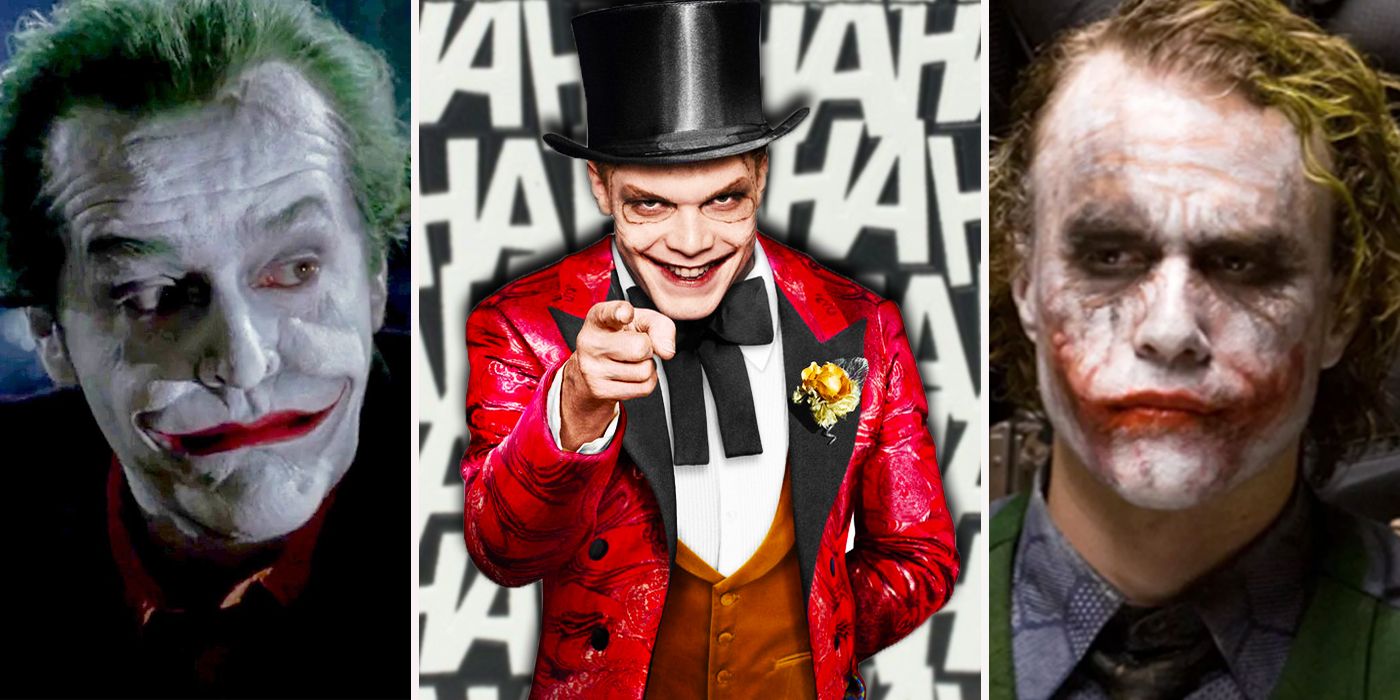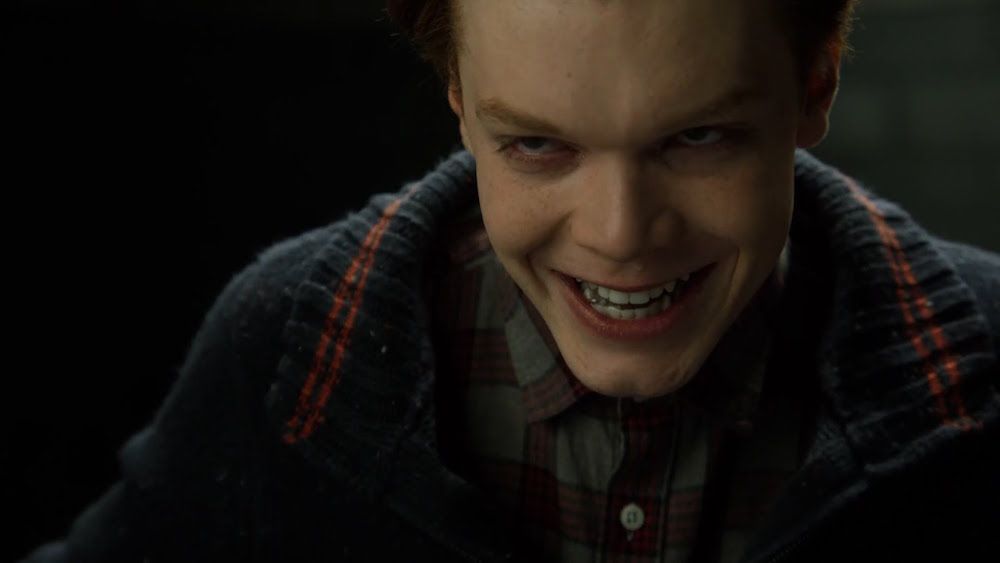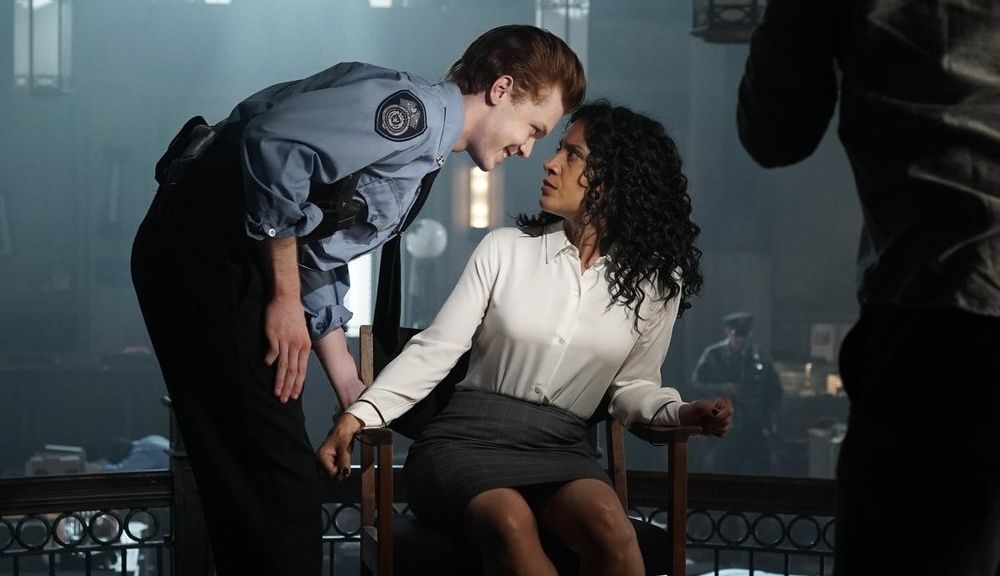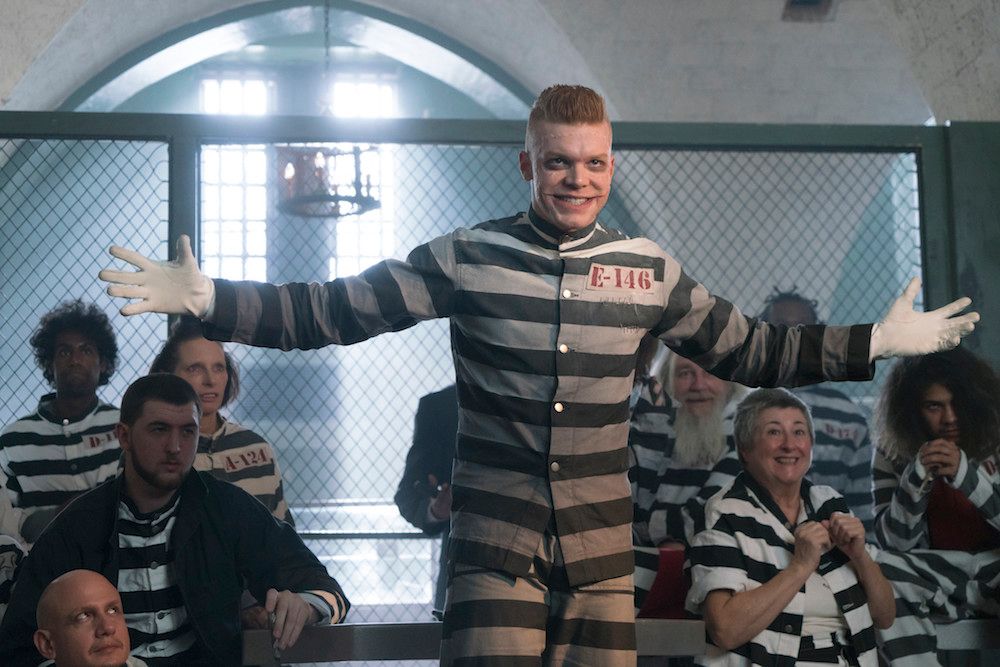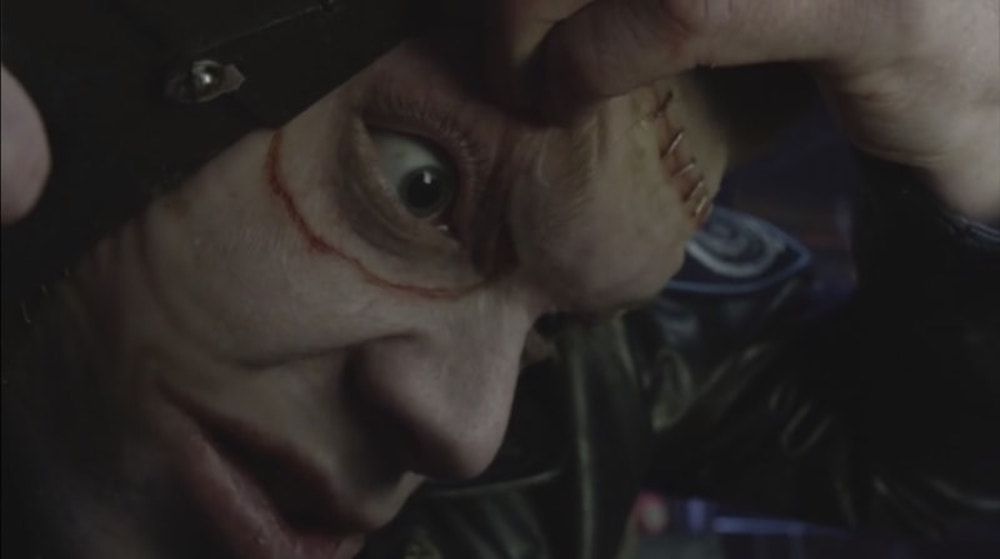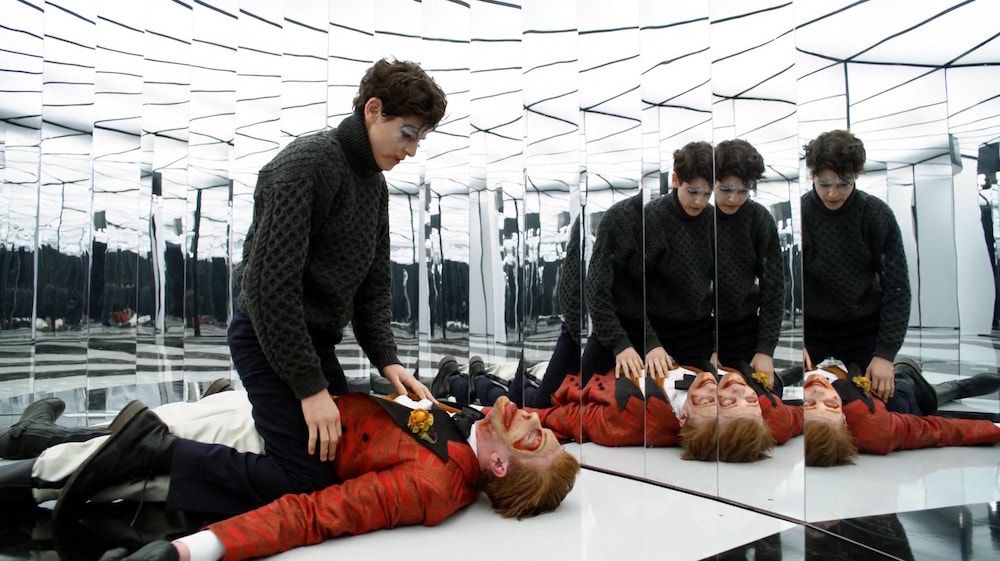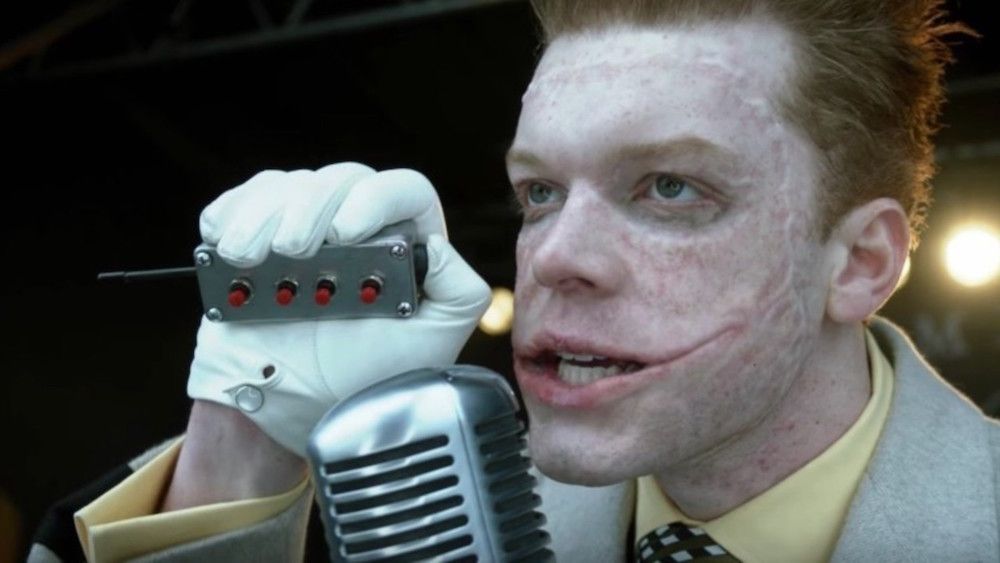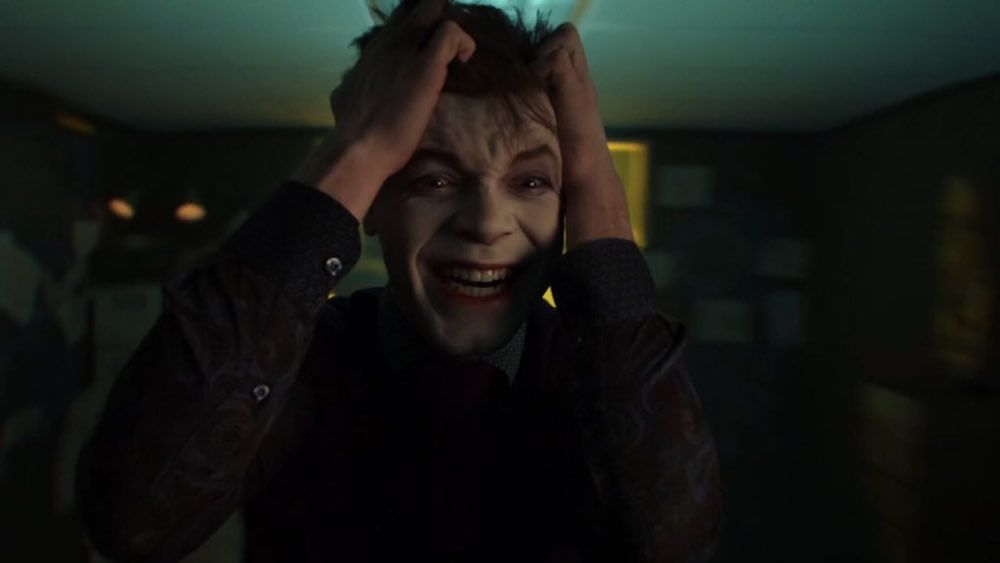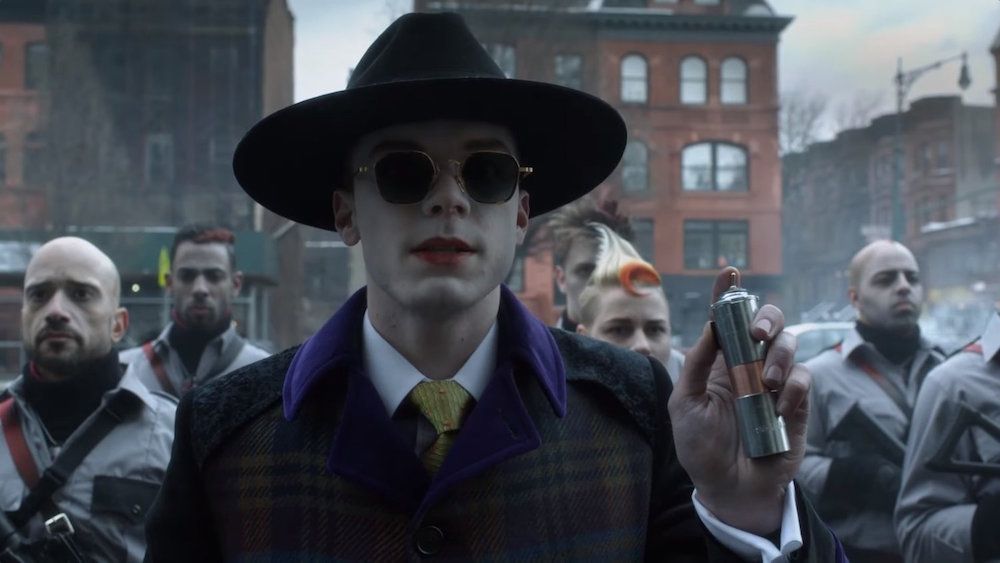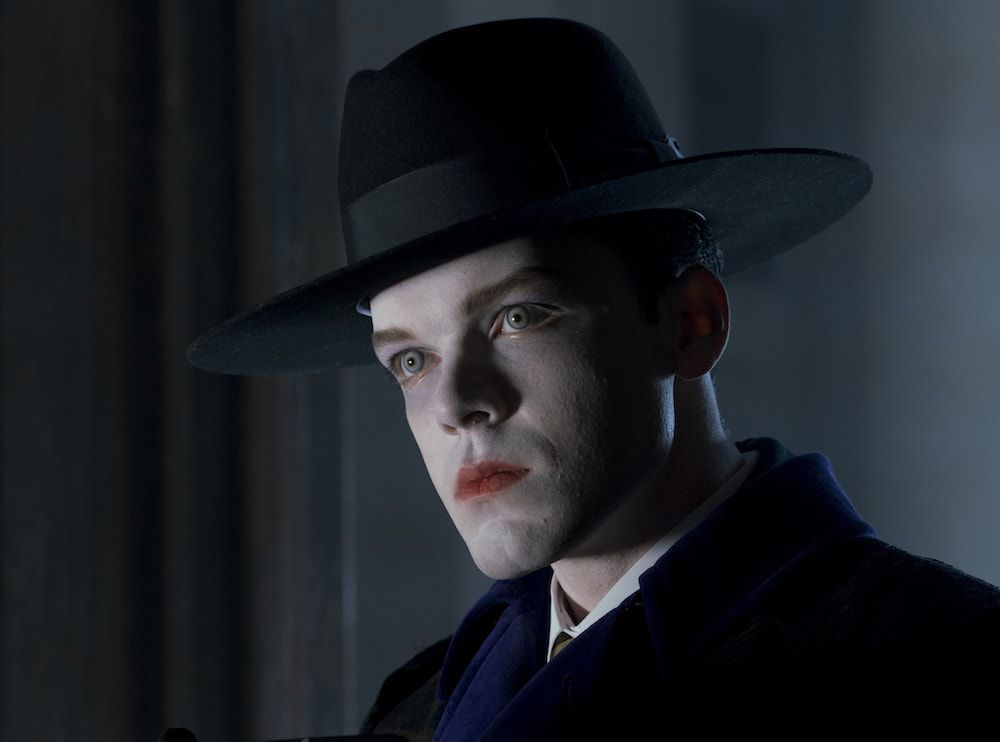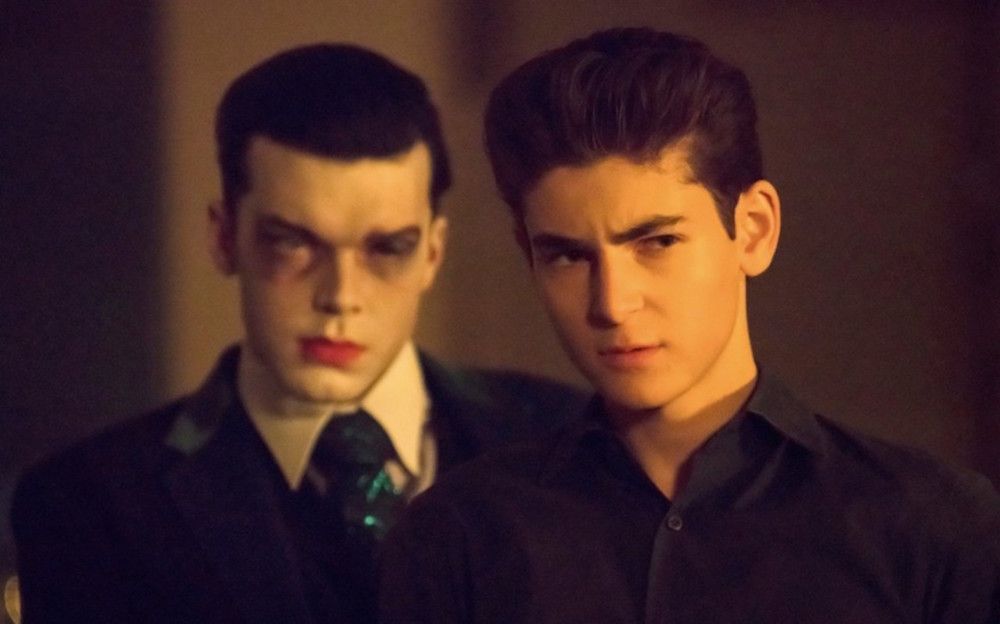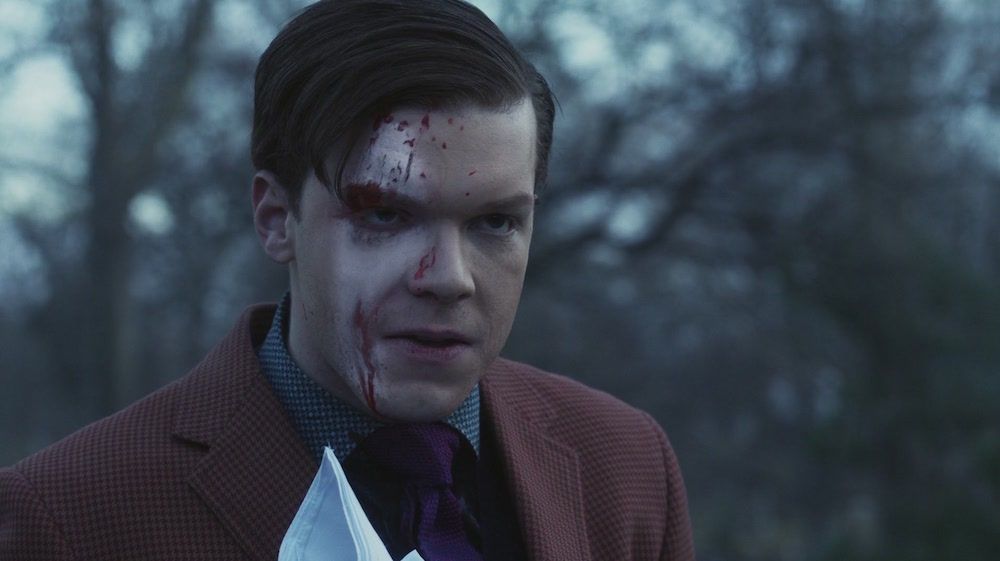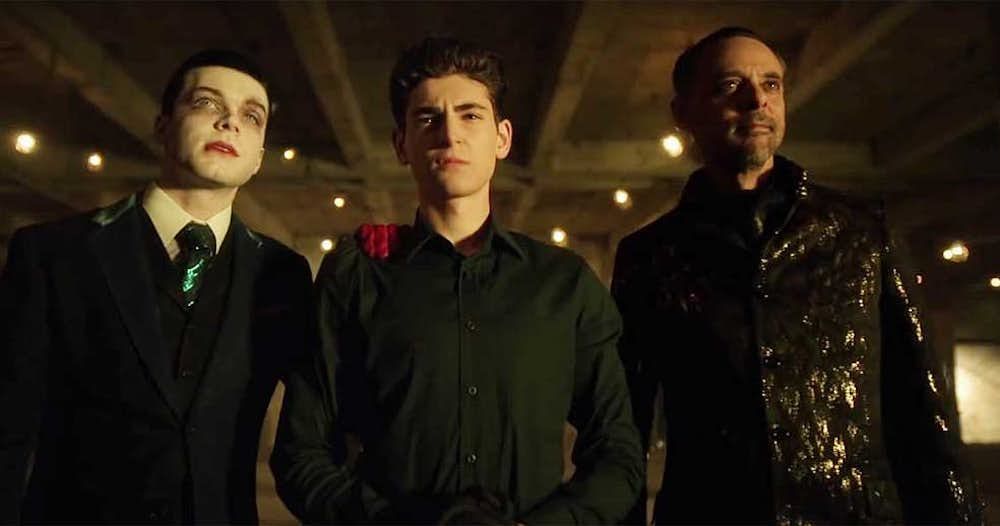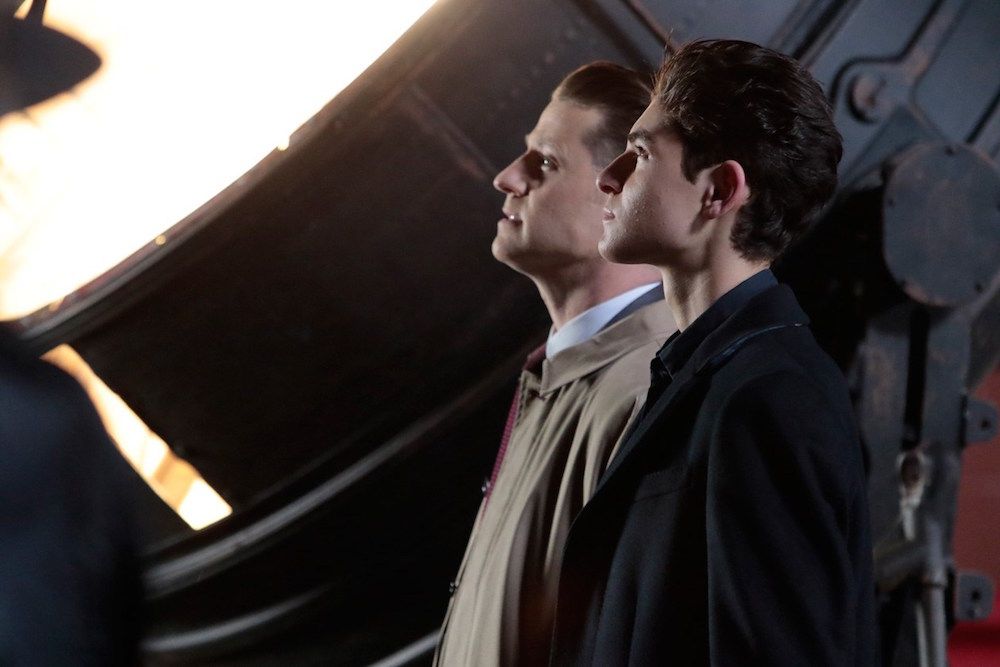Gotham has set the stage for the Dark Knight to rise with its explosive Season 4 finale. While the show has taken various turns and veered from established canon, it remained dedicated to telling the stories of characters essential to the Batman universe. One storyline fans hoped would be told was that of the Joker. Teasing the villain's presence in the city, Gotham introduced Jerome Valeska who embodied many of the criminal mastermind's sadistic mannerisms. While many were led to believe he would don the white makeup and purple suit, it soon became obvious that he would act as the inspiration for someone to take on the mantle.
Late in Season 4, the surprise appearance of his twin Jeremiah shocked viewers. So far, the character has proven to be even more calculated than his crazed brother; giving us an inspired handful of some of Joker's greatest comic-book moments. Despite confirmation that the Joker won't make an onscreen appearance on the show, The Valeska Twins have done a fine job paving the way for the emergence of the Clown Prince of Crime in the unforeseen future. Below are reasons why Gotham's unofficial Jokers deserve to be recognized among the rest of the crazy clown crew.
15 PUT A SMILE ON THAT FACE
One of the Joker's most recognizable traits is his maniacal laugh, best portrayed by Mark Hamill in Batman: The Animated Adventures. Wanting to develop a range for the character, Hamill described the process of defining the laugh by "find[ing] places to open little windows into the psyche of this psycho." In "The Blind Fortune Teller," Jerome Valeska was able to perfectly capture the terror-inducing power of such a diabolical chuckle. Beginning with a series of uncomfortable giggles, Jerome unleashed the sinister laughter after being found guilt of the murder of his mother.
Along with his laugh, the Joker is also known for his various personalities, each portrayed by a different actor over the years. In the 1960s, he was nothing more than a fun-loving prankster played by Caesar Romero while in recent years, darker aspects of his personalities have played out in the forms of Heath Ledger's chaotic anarchist in The Dark Knight and Jared Leto's attention-seeking gangster in Suicide Squad. When first introduced to Jerome, he appears as a fragile young man mourning the loss of his beloved mother. Slowly, this false persona begins to unravel to make way for his true nature as a ruthless, apathetic killer tired of having to deal with the nagging from an unfit parent.
14 WHY SO SERIOUS
The Joker is very much defined by his chaotic actions. Not concerned about money, attention, even power, he just wants to turn Gotham into his own madhouse. Taking inspiration from Ledger's portrayal, Jerome delights in inciting terror in the city's inhabitants and making videos of himself torturing others. Disguising himself as a member of the GCPD, he leads a massacre that ends in the death of Commissioner Sarah Essen. The act traces its roots to Ledger's performance where he pretends to be a member of the Honor Guard at Commissioner Loeb's funeral and shoots Jim Gordon. After being taken to the GCPD, he makes his escape using a cell-phone bomb planted inside one of the prisoner's chests.
After the riot, Jerome broadcasts a message to Gotham's citizens explaining how they've become complacent living as "little, tiny cogs in a giant absurd machine." Urging them to be free of this prison they've created for themselves, he tells them to give into the rising insanity plaguing the city. His speech bears an eery resemblance to the conversation Ledger's Joker has with Harvey Dent when he mentions that no one panics when everything "goes according to plan." By introducing anarchy into the equation, both characters have upset the balance and challenged the authority of the GCPD who are attempting to bring about justice to the crime-ridden streets and the powerful crime lords wanting to establish their reign over the city.
13 AN AGENT OF CHAOS
Jerome is one of the few villains on Gotham that has demonstrated a powerful influence over the city and its inhabitants. Much like Ledger's Joker, Jerome draws out the insanity in people and preys upon the mentally ill. As the leader of the MANIAX, a group of fellow Arkham Asylum escapees, he attacks a bus full of cheerleaders by dousing them in gasoline and threatening to set them on fire. The scene is an homage to the beginning of The Dark Knight where Ledger's Joker uses school buses to disguise a bank robbery.
After his death at the hands of Theo Galavan, his presence is still felt as copy-cats begin to descend upon the city. His legacy of "death and madness" descends upon Gotham as various news channels report on his passing. Viewers begin to undergo severe mental breakdowns and start to mimic Jerome's insane laughter. On the streets, two men murder a homeless man before turning on each other, stabbing the other to death. In honor of their fallen idol, a "Cult of Jerome" is formed and taken over by devoted fanatic Dwight Pollard. The actor also made an appearance in The Dark Knight as one of the Joker's followers; a paranoid schizophrenic named Thomas Shift who disguises himself among the Honor Guard at Commissioner Loeb's funeral and aids in the kidnapping of Rachel Dawes.
12 IN NEED OF A FACE-LIFT
Drawing from the events in the New 52 reboot, Jerome's face is cut off my a deranged fan named Dwight Pollard after what appeared to be a failed attempt at resurrecting his fallen idol. Announcing "Jerome is here", Pollard makes his debut before the underground cult and declares himself their new leader. Waking up in the GCPD's morgue, a newly revived Jerome tracks down Dwight, retrieving his stolen face and in a cringe-worthy DIY moment, staples it back on. In a live-broadcast, he then urges the citizens of Gotham to join him by finding their own rebirth by committing violent acts.
In the comics, the Joker has his face surgically removed by the Dollmaker while locked away in Arkham Asylum. To announce his return after a year of hiding, he attacks the GCPD and after reattaching his face, broadcasts a warning that the major will die. Dwight's wearing of Jerome's face references Duela Dent's actions in the one-shot Batman: The Dark Knight #23.4. After finding the Joker's severed face in the sewers beneath Gotham, she begins claiming herself as "The Joker's Daughter." The character made her first appearance in Batman Family #6 and has joined forces with the Teen Titans and the Suicide Squad.
11 DESTINED TO DO THIS FOREVER
Drawing inspiration from Frank Miller's The Dark Knight Returns and Alan Moore's The Killing Joke, Jerome and Bruce have an epic confrontation in the House of Mirrors that lays the foundation for one of the most deeply complex relationships between a hero and villain in the DC Universe. Referencing the "You won't kill me / I won't kill you" moment from The Dark Knight, Bruce finds himself savagely beating Jerome with the intent to kill him using a broken mirror shard. Realizing at the last second that he doesn't want to stoop to Jerome's level and become a murderer, Bruce regretfully spares him.
This moment emphasizes the fact that Batman and Joker will always be at each other's throats but can't bring themselves to kill one another. As Ledger's Joker stated to Batman, "you complete me": there would be no need for one without the other. In his madness, Jerome wanted to prove that "Gotham has no heroes" by corrupting Bruce's sense of morality. The Joker is the reason for Batman's "one rule" and as Alfred makes Bruce aware "there is a very fine line between justice and vengeance," he establishes the rule that Bruce must never cross that line.
10 MAKE THEM LAUGH
Recalling the parade scene from Batman (1989) where Jack Nicholson's Joker releases his Smilex Gas on the citizens of Gotham, Jerome attempts to recreate the moment in a much more terrifying way. Wanting to "paint the town crazy," he assembles the city's most notorious villains as his "Legion of Horribles." Using the talents of Scarecrow and Jervis Tetch, he creates a toxic laughing gas to unleash upon Gotham using a hijacked blimp. Crashing a concert being held in the middle of the city, Jerome brings out members of Gotham's elite and straps bombs to their necks, threatening to kill them and release the gas if his demands aren't met. Taking a nod from Ledger's Joker and the boat bomb scene from The Dark Knight, he leaves the fate of Gotham's citizens in the hands of the GCPD who attempt to beat him at his own game.
In the episode, entitled "Mandatory Brunch Meeting," a twist in what was believed to be the show's reinterpretation of the Joker's origin is revealed in the form of Jerome's twin brother Jeremiah. Forced to explain his uncanny resemblance, Jeremiah recalls his abusive childhood and being sent away to a private school as a means of escape. While not a direct source of inspiration, the idea of a long lost brother was used in Batman: The Court of Owls when it was suggested Bruce Wayne had an older sibling named after his late father who was sent away to live in an orphanage.
9 GO WITH A SMILE
In a tribute to Nicholson's Joker and his fatal fall in Batman (1989), Jerome plunges to his death, landing on a parked car where a group of people gather around his body. The camera pans to focus on his signature grin still plastered on his face even in death. After his plans were thwarted once again, Jerome was chased by Gordon to a rooftop where he is shot, causing him to fall off the edge. Similar to the scene in The Dark Knight where Batman throws Joker off the edge of a building only to save him at the last moment, Gordon finds himself reaching out to grab Jerome who is struggling to hold onto a pipe jutting out from the building. Remarking the situation poses "quite the dilemma," Jerome teases Gordon by withdrawing his hand from Gordon's grasp, declaring his downfall will always be his attempt to "play by the rules."
Before plunging to his death, Jerome's parting words state his memorable legacy: "I'm more than a man. I'm an idea, a philosophy. And I will live on in the shadows within Gotham's discontent." While this appears to be the end of Jerome's reign of madness, just like Ledger's Joker, he reveals he has one more trick up his sleeve; an "ace in the hole" that threatens to change everything and ensure his lasting terror.
8 DESCENT INTO MADNESS
Proving it takes just "one bad day" to turn someone's world upside-down, Jerome ensures the continuation of his legacy by surprising his twin brother Jeremiah with a special version of his toxic laughing gas. Keeping in mind Joker's belief that "madness... takes a little push," Jerome unleashes the darkness in Jeremiah and tells him to "be my ultimate revenge." Flailing about the room in an attempt to fight the transformation, Jeremiah's skin begins to turn a pale white and a wide grin spreads its way across in face. In a recreation of Joker's origin from The Killing Joke, the episode ends with Jeremiah grasping the sides of his skull as the room is engulfed by crazed laughter.
Borrowing a makeup tip from Nicholson's Joker, Jeremiah hides the "mild cosmetic effects" the toxin had on him using foundation and plays an elaborate mind-game on Gordon and Bruce. Using the Joker's strategy of always being ten steps ahead of his opponent, Jeremiah uses the growing fear that Jerome has returned from the dead once again. Trapped in an underground bunker with a bomb, Gordon is shocked by a video which shows what appears to be Jerome being strangled by an unseen entity. Instead of signaling his return, the video turns out to mark the debut of Jeremiah as a much more sinister force than his brother. After seemingly killing Gordon in an explosion, Jeremiah announces his plans to Bruce to fulfill his brother's twisted desires to a much more fulfilling end.
7 NOT A LAUGHING MATTER
Pledging their allegiance to their new leader, Jeremiah takes his brother's former cult to the GCPD to announce the death of Jim Gordon and reveal his plans to build Gotham anew. At the steps of the GCPD, Jeremiah tells Harvey Bullock that he has planted bombs in various locations around the city and that the police have six hours to evacuate the city. If they don't comply with his demands, the city will go up in smoke and millions will die. Horrified, Bullock remarks, "You're more sick than your brother." Not wanting to be compared to his lesser half, Jeremiah responds "he just wanted to destroy things. Me, I'm a builder." Coming to the conclusion that the slate must be wiped clean before he can rebuild Gotham, Jeremiah emphasizes the sincerity of his words by blowing up the city's clock tower.
This act sets the stage for the events of Batman: No Man's Land where Gotham is evacuated after a devastating earthquake, leaving the city to fall into ruin. For fans of Birds of Prey, the clock tower bears a strong significance. After the events of The Killing Joke, a paralyzed Barbara is forced to toss aside her vigilante life as Batgirl and become Oracle, establishing her base of operations inside the clock tower.
6 DANCE WITH THE DEVIL
Just like Jerome draws inspiration from Ledger's Joker in The Dark Knight, Jeremiah's mannerisms are reminiscent of another iconic Joker. He has a cringe-worthy charm about him -- suave with a dash of sinister -- that mirrors Jack Nicholson's performance in Batman (1989). Speaking as if he's making a business deal, Jeremiah uses a calm, matter-of-fact tone as he threatens to blow Gotham sky-high. The use of makeup to hide his altered pigmentation is also a nod to Nicholson disguising his disfigurement with foundation during various scenes in the film.
Cameron Monaghan, who plays both of the Valeska twins, was inspired by another of Nicholson's performances when portraying Jeremiah. "One of the main characters we modeled Jeremiah from is Hannibal Lecter" he stated in an interview with ComicBook.com, revealing he was drawn how the character always remained the smartest person in the room despite the circumstances. That intelligence "is something that Jeremiah has. No matter how this guy is backed into a corner, he plans for contingency... He can take control." When it's revealed that Gordon has somehow survived the bunker explosion and his bombs have been defused, Jeremiah's new followers begin to turn on him, believing their old master was far better than his current replacement. Angered but ultimately not surprised by their lack of faith, Jeremiah traps them inside one of the rooms within his maze and incinerates the cult members.
5 REV UP YOUR HARLEY
What would Joker be without his Harley Quinn? In "Mandatory Brunch Meeting," we are introduced to Jeremiah's proxy and loyal assistant Ecco. Demonstrating her extreme dedication to Jeremiah and his safety, she shows prowess as a martial artist and skilled marksman. Upon Jerome's death, she appears as "The Mummer" in a jester outfit and white face mask. Using a blow horn, she rallies his former cult members to dig up Jerome's body and bring him to the GCPD for his wake. In Batman: No Man's Land, upon which the latter portion of this season of Gotham is heavily based, Echo is the alias used by Russian assassin Isabelle Cheranova.
As soon as fans decided Jerome was the Joker, they were eager to learn when his beloved bombshell would make an appearance. Writers for the show teased that she would show up and with this particular scene, people were quick to claim Ecco as the psychiatrist turned psycho made famous by Bruce Timm and Paul Dini in Batman: The Animated Adventures. Her devotion to Jeremiah is evident but hints at their professional relationship turning romantic remain to be seen. Also, now that it's been well-established Joker will not appear on the show, it's safe to say neither will Harley Quinn. Perhaps similar to Jeremiah and Jerome, Ecco will serve as an inspiration for the clown's mad lover.
4 MY VERY BEST FRIEND
Unlike Jerome's bond with Bruce that was solely based on obsession, Jeremiah's friendship with Bruce is based on a shared recognition of the other's trauma. At a young age, Bruce witnessed the death of his parents and has carried that guilt with him ever since. After suffering abuse from his brother, Jeremiah was taken away from his mother and from his home at the circus. Each felt the need to suppress their anger by burying it deep within themselves.
Much like the Joker seeks to push Batman over the edge in an attempt to make him a better adversary, Jeremiah wishes to help Bruce embrace his "true nature". Feeling responsible for Jeremiah's sudden change, much like Batman's feels responsible for his part in creating the Joker, Bruce vows to put an end to his plans to destroy Gotham. Not wanting him to intervene and force his hand, Jeremiah states that he doesn't want to kill Bruce because he considers him to be his "very best friend." The Joker and Batman's twisted co-dependant relationship prevents them from drastically altering the other's motives. When Batman attempts to offer rehabilitation in The Killing Joke, the Joker remarks that it's "far too late" for him to be saved.
3 JEREMIAH'S KILLER JOKE
"One Bad Day" draws inspiration from one of the most controversial Batman storylines ever written. The Killing Joke, written by Alan Moore, begins with the origin story of how a failing stand-up comedian became one of the greatest villains of the DC Universe. Fast-forward a few years and in one of the most disturbing attacks on the extended Batman family, the Joker shoots Barbara Gordon in the abdomen and tortures her father with images of her stripped naked and savagely beaten.
In his recreation of these events, Jeremiah attacks Bruce by torturing Alfred and shooting Selina Kyle. Using the same laughing gas his brother used, Jeremiah subjects Bruce to projections of his beloved butler being beaten and driven insane, carving a grin on his face with a straight-razor. What appears to be a devastating transformation turns out to be an illusion broken when Selina shoots "Alfred," who turns out to be an actor and reveals Bruce has been hallucinating the entire time. Back at Wayne Manor, Jeremiah interrupts a romantic moment between Bruce and Selina by shooting her in the abdomen, severely damaging her spine. What makes this version more disturbing than the original is that this is a direct attack on those Bruce cares about most, driving him to make the ultimate sacrifice of leaving them behind to save Gotham from Jeremiah's brutal reign.
2 THE ENEMY OF MY ENEMY
Making the statement "it's not just about Gotham. This is about Bruce Wayne," Gotham formed an alliance between two of Batman's greatest foes to help build the foundation for the birth of the Dark Knight. Seeing Bruce as the brother he never had, Jeremiah becomes his ultimate adversary and paves the way for the emergence of a greater enemy to challenge Bruce in the future. Ra's al Ghul creates the need for a "knight in the darkness" by turning the city into a chaotic wasteland in desperate need of a savior. By joining forces and blowing the bridges to the city, Gotham is cut off from the outside world and Bruce is left with no choice but to face the responsibility of helping the city during its time of need.
Fans of Nolan's trilogy will recognize elements of the movies referenced in the episode which heavily based on the events of Batman: No Man's Land. Batman Begins introduced Ra's al Ghul who wanted Bruce to confront his anger, using it to fuel his actions and become a merciless enforcer of justice. While Ra's believes Gotham needs to be harshly purged of its sins, Bruce holds firm in his belief that his city can still be saved. When confronted by the Joker in The Dark Knight, Batman learned that in his constant pursuit of justice, he must never let himself be pushed to the edge and become like the villains he apprehends.
1 THE DARK KNIGHT RISES
Season 4 of Gotham came to a devastating end as audiences were left with an image of the city falling into ruin. To quell their anguish, FOX has renewed the show for a fifth and final season, which promises to delve deeper into the Batman mythos. Though the producers have explicitly stated the Joker will never make an appearance on the show, the Valeska twins' influence is still running rampant: Jerome's embodiment of the Joker's "anarchist wildness" while Jeremiah continues to show "a different sort of controlled insanity and a level of genius planning" portrayed in many of the comics. As Bruce continues to mature into the hero he's meant to be and Jeremiah descends further into madness, all of the pieces of Batman's mythology will finally come together in what hopes to be a memorable conclusion to the series.
During the finale, as the city became consumed in chaos, many of the iconic villains carved territories for themselves in various parts of Gotham. Among them were glimpses of new foes such as Man-Bat and Mother and Orphan. During the city's most desperate hour, Jim Gordon shown a make-shift Bat Symbol in the dark skies above the city and Bruce was there to answer the call. Leaving us with the declaration "the world may seem dark, but there is light," viewers were left with the hope that Gotham will be saved by its Dark Knight.

